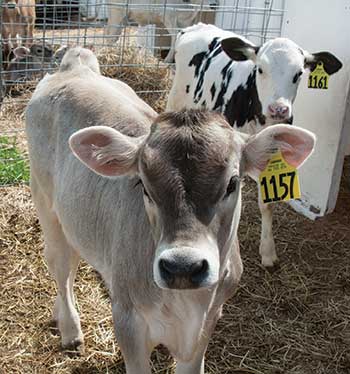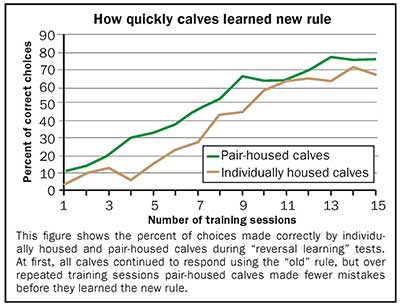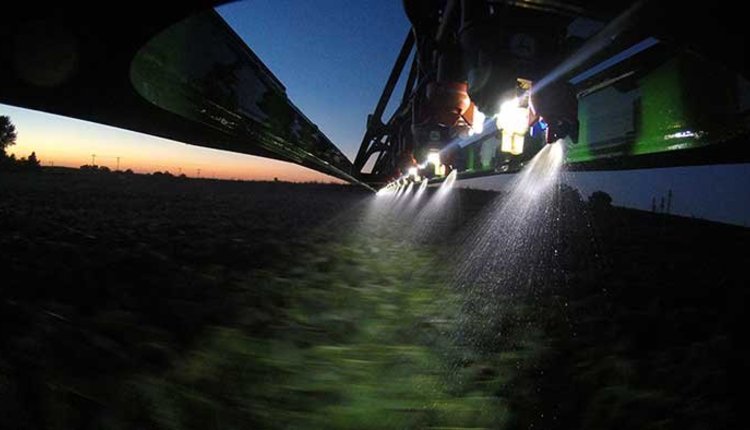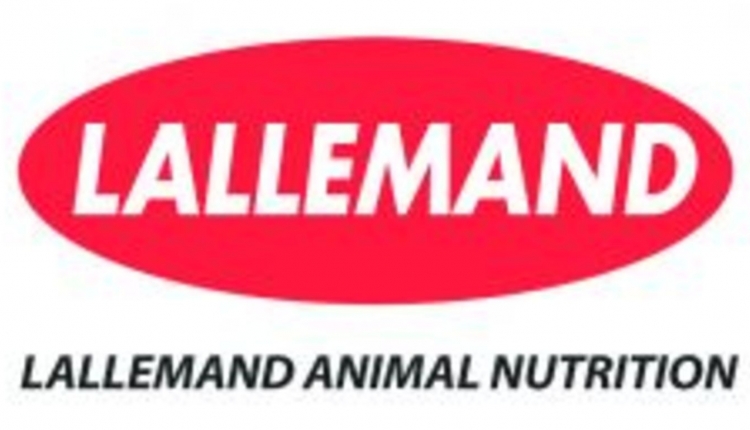The authors are a postdoctoral fellow and two professors from the University of British Columbia Animal Welfare Program.

Calves raised in pairs may handle change better and learn more quickly than individually housed calves, new research has shown
Individual housing for milk-fed calves is common practice on most North American dairy farms and calf ranches. More recently, some farmers began exploring alternatives such as pair housing, which allows calves to interact socially. A series of studies from the University of British Columbia have shown reduced weaning distress and improved growth rates when calves are pair housed.
Some learn more quickly
The results of their most recent study published in PLoS One suggest that individual housing causes a cognitive deficit in young calves. This may explain why calves raised in groups are able to outperform the individually reared calves.
In the study, researchers housed calves either in an individual pen or as a pair in a double pen. All calves received 4 quarts of milk in the morning and again in the evening using a nipple bottle. Calves had access to calf starter, hay and fresh water.
To test their learning ability, calves were trained with a simple "Y-maze." Calves could enter one arm of the pen and approach a white bottle that contained milk or enter the opposite arm of the pen and approach a black bottle that was empty. The white bottle provided the calves with a "reward" of several sips of warm milk. Approaches to the black bottle were "punished" with a few second "time out" during which the calves waited to re-enter the maze.
After a few days of training, all calves quickly learned to approach only the white bottle. They learned the pattern well, but in the life of the modern dairy cow rules often change. Cows are moved to new pens, introduced to changing diets and different penmates, and on many farms cows must also learn to adapt to new technologies, including automated feeding and milking equipment.
Dealing with change
To test how well the calves could cope with change, the experimenters altered the rules of the learning task - now the white bottle was empty and visits to this side of the maze were punished with a time out while visits to the black bottle were rewarded with milk. This means the calves had to reverse what they had initially learned.
All calves struggled at first with the new rules, but after several days of training the individually housed calves continued to often visit the now empty white bottle while the pair-housed calves learned to preferentially visit the arm with the black bottle of milk (see Figure). In other words, the individually housed calves made more mistakes when the rules of the game changed. Earlier work with laboratory animals has shown similar results; individually housed animals are less able to learn when aspects of their environments are changed.
The simplest form of learning is called habituation - animals typically "habituate" to things around them by showing less interest in a stimulus after being exposed to it for some time. To test how the type of housing affects habituation in milk-fed calves, the researchers placed a red feed bin that calves had not seen before into a test pen with the calves that had been either individually reared or reared in pairs. Not surprisingly, calves from both housing treatments spent time investigating the red feed bin at first. But when tested again and again with the same red bin, the individually housed calves continued responding as if they had never seen the object before while the paired calves quickly learned to ignore the bin.
Lifelong implications?
Why should learning difficulties in dairy calves matter to dairy farmers? Until now, few people would have guessed that our standard way of housing calves is causing a cognitive deficit. Now, at least some people may be concerned that we are somehow making our calves less than what they could otherwise be. At a more practical level, these deficits may make routine practices more difficult for calves to handle.

Click here to return to the Calf & Heifer E-Sources

Individual housing for milk-fed calves is common practice on most North American dairy farms and calf ranches. More recently, some farmers began exploring alternatives such as pair housing, which allows calves to interact socially. A series of studies from the University of British Columbia have shown reduced weaning distress and improved growth rates when calves are pair housed.
Some learn more quickly
The results of their most recent study published in PLoS One suggest that individual housing causes a cognitive deficit in young calves. This may explain why calves raised in groups are able to outperform the individually reared calves.
In the study, researchers housed calves either in an individual pen or as a pair in a double pen. All calves received 4 quarts of milk in the morning and again in the evening using a nipple bottle. Calves had access to calf starter, hay and fresh water.
To test their learning ability, calves were trained with a simple "Y-maze." Calves could enter one arm of the pen and approach a white bottle that contained milk or enter the opposite arm of the pen and approach a black bottle that was empty. The white bottle provided the calves with a "reward" of several sips of warm milk. Approaches to the black bottle were "punished" with a few second "time out" during which the calves waited to re-enter the maze.
After a few days of training, all calves quickly learned to approach only the white bottle. They learned the pattern well, but in the life of the modern dairy cow rules often change. Cows are moved to new pens, introduced to changing diets and different penmates, and on many farms cows must also learn to adapt to new technologies, including automated feeding and milking equipment.
Dealing with change
To test how well the calves could cope with change, the experimenters altered the rules of the learning task - now the white bottle was empty and visits to this side of the maze were punished with a time out while visits to the black bottle were rewarded with milk. This means the calves had to reverse what they had initially learned.
All calves struggled at first with the new rules, but after several days of training the individually housed calves continued to often visit the now empty white bottle while the pair-housed calves learned to preferentially visit the arm with the black bottle of milk (see Figure). In other words, the individually housed calves made more mistakes when the rules of the game changed. Earlier work with laboratory animals has shown similar results; individually housed animals are less able to learn when aspects of their environments are changed.
The simplest form of learning is called habituation - animals typically "habituate" to things around them by showing less interest in a stimulus after being exposed to it for some time. To test how the type of housing affects habituation in milk-fed calves, the researchers placed a red feed bin that calves had not seen before into a test pen with the calves that had been either individually reared or reared in pairs. Not surprisingly, calves from both housing treatments spent time investigating the red feed bin at first. But when tested again and again with the same red bin, the individually housed calves continued responding as if they had never seen the object before while the paired calves quickly learned to ignore the bin.
Lifelong implications?
Why should learning difficulties in dairy calves matter to dairy farmers? Until now, few people would have guessed that our standard way of housing calves is causing a cognitive deficit. Now, at least some people may be concerned that we are somehow making our calves less than what they could otherwise be. At a more practical level, these deficits may make routine practices more difficult for calves to handle.

For example, after weaning, calves are nearly always kept in groups and must learn to adjust to new surroundings, group mates, feed and so forth. Some of our previous research has shown that individually housed calves struggle with the very first change in housing that they are exposed to - moving to a group pen. During this transition, the previously individually housed calves spend less time eating and gain less weight than calves that were pair housed.
If the learning deficits persist, then cows may also be more difficult to manage than would be the case if they had been socially reared as calves. Research is being done to answer this question and also examine how early in the calf's life social housing must begin to obtain these positive benefits.
We've known for years that some form of social housing improves early intakes of solid feed and improves weight gains before and after weaning. This new research now shows that this is likely due in part to the socially reared calves being better learners and better able to adapt to changes in their environment. Calves show these benefits even when using the simplest of "groups" - a pair of calves kept in a double calf pen.
1407_445








